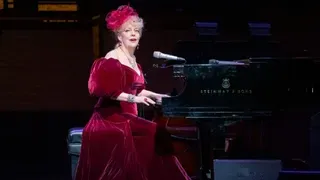March 13, 2014
"Women Who Rock" Exhibit Now on Tour
Winnie McCroy READ TIME: 6 MIN.
Cleveland's Rock and Roll Hall of Fame and Museum is now touring their groundbreaking and provocative exhibit "Women Who Rock: Vision, Passion, Power." The exhibit is traveling from city to city to illustrate the important roles women have played in rock and roll, from its inception through today.
"Women Who Rock: Vision, Passion, Power" highlights the flashpoints, the firsts, the best, the celebrated -- and sometimes lesser-known women -- who moved rock and roll music and American culture forward," reads their press statement.
The interactive exhibition spotlights more than 70 artists with artifacts, video and listening stations, and a recording booth where visitors can film a short story or moment of inspiration related to women in rock. The exhibit moves through the rock and roll eras, weaving a powerful and engaging narrative that demonstrates how women have been the engines of creation and change in popular music, from the early years of the 20th century to the present.
Trailblazers
Exhibits include Suffragettes to Juke-Joint Mamas: The Foremothers / Roots of Rock. In the 1920s, blues women like Ma Rainey and Bessie Smith were the first -- and for a while, the only -- artists to record the blues. Mother Maybelle Carter made the first country music recordings in 1927.
American women of this era made great strides toward gaining equality and basic human rights for themselves and others in society, including attaining the right to vote and working toward social justice. The narrative of these groundbreaking women is presented along with the stories of trailblazers such as Mahalia Jackson, Sister Rosetta Tharpe and Billie Holiday.
Rebels With a Cause
"How many of us know the names of the pioneer women songwriters/singers/musicians of the '50s?" is a question asked by Yoko Ono in her preface to "She's a Rebel: The History of Women in Rock and Roll."
LaVern Baker and Brenda Lee shine in Get Outta That Kitchen, Rattle Those Pots and Pans: Rock and Roll Emerges. Ruth Brown and Wanda Jackson were two predominant roots of rock, R&B and country/rockabilly.
Though sometimes seen as puppets manipulated by unseen and mostly male handlers, girl groups as profiled in Will You Love Me Tomorrow: The Early 1960s/Girl Groups, were an authentic manifestation of the worldview of teenage girls, a group just coming into its own in the early 1960s and increasingly recognized for its growing economic power as consumers and arbiters of style.
Revolution
The girl groups reflected teenage girls' explorations of their world, their limitations and their limitless potential. Groups like the Shangri-Las and the Ronettes give voice to those explorations and the possibilities that waited down the street or just around the corner.
In Revolution, the Counterculture and the Pill: The Late 1960s American Society, the revolutionary work of African-Americans and women emerged. Janis Joplin was the finest white blues singer of her generation; female singer-songwriters like Carole King, Joni Mitchell and Laura Nyro bared their souls, and Aretha Franklin became known as The Queen of Soul. Bonnie Raitt established herself as both a strong vocalist and brilliant guitarist. Highlighted artists will also include Tina Turner and Grace Slick, as well as country artist Loretta Lynn.
Modern-Day Rockers, Punk to Pop
The exhibit also covers the more recent movements of women into disco, punk and pop. In I Will Survive: The 1970s, Rockers to Disco Divas, the gains of the feminist movement throughout the '70s enabled women working in all areas of the music industry to assume more control over their careers. The exhibit profiles the work of Donna Summer, Joan Jett and the Runaways, Heart and Fleetwood Mac.
"That was the beauty of the punk thing: [Sexual] discrimination didn't exist in that scene," said rocker Chrissie Hynde of the exhibit Dance This Mess Around: Punk and Post Punk. The DIY aspect of punk rock made it easier for a woman to find a place in music. Highlighted artists will include Yoko Ono, Siouxsie Sioux, Kate Pierson and Cindy Wilson of the B-52s, Deborah Harry, Tina Weymouth, Kim Deal and Marianne Faithfull.
Queens of Pop
With the '80s came the new queen of pop, Madonna. Her meteoric ascent is chronicled in the exhibit Causing a Commotion: Madonna and the Pop Explosion. The artist unapologetically celebrated and monetized her sexuality and physicality, paving the way for female performers to explore previously taboo roles and take control of their image and career.
Highlighted artists include Madonna, Cyndi Lauper, Britney Spears, Christina Aguilera, Gwen Stefani and Janet Jackson.
The '90s saw the emergence of the riot grrrl scene, rap and Lilith Fair, which reshapied traditional ideas of feminism and traditionally male-dominated areas of the music industry. Women have arguably become the leading voices of the industry, standing -- army-booted, bare-footed, or high-heeled stiletto -- toe to toe with any artist of today.
Highlighted artists in the exhibit Ladies First: The '90s and the New Millennium include Bikini Kill, Meg White, Queen Latifah and Lady Gaga.
Women Who Rock appears at Phoenix's Musical Instrument Museum through April 20.
mim.org
The exhibit then travels to The Henry Ford Museum in Detroit, Mich. from May 17 - August 17, 2014.
thehenryford.org
Women Who Rock is sponsored by PNC, Time Warner Cable and Biography. To learn more about the exhibition visit http://rockhall.com/exhibits/women-who-rock/
Winnie McCroy is the Women on the EDGE Editor, HIV/Health Editor, and Assistant Entertainment Editor for EDGE Media Network, handling all women's news, HIV health stories and theater reviews throughout the U.S. She has contributed to other publications, including The Village Voice, Gay City News, Chelsea Now and The Advocate, and lives in Brooklyn, New York.




